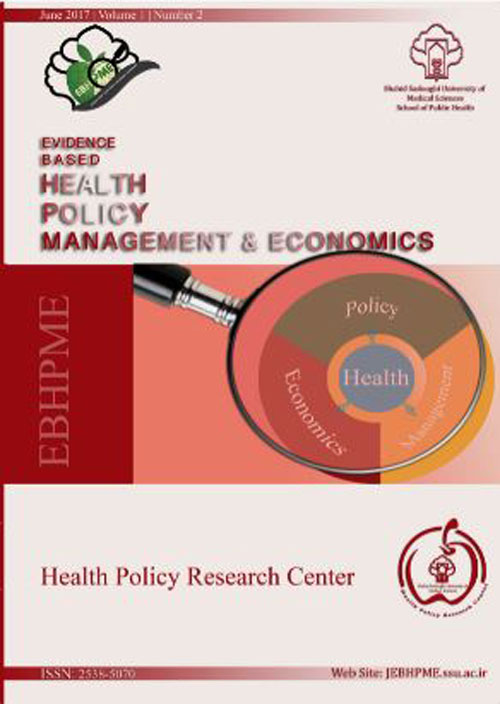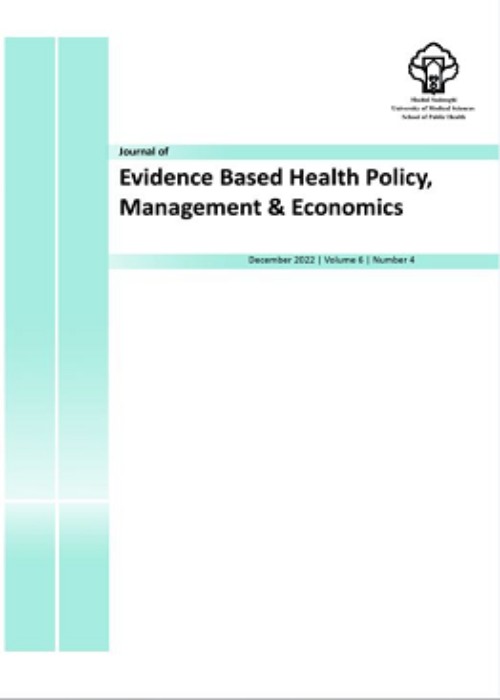فهرست مطالب

Journal of Evidence Based Health Policy, Management and Economics
Volume:5 Issue: 2, Jun 2021
- تاریخ انتشار: 1400/04/12
- تعداد عناوین: 8
-
Pages 78-89Introduction
Medical tourism is a fast-growing industry that has provided special opportunities for international organizations to achieve a competitive advantage. This research has been conducted to recognize and prioritize the factors affecting the admission of medical centers into the medical tourism market in Iran.
MethodsThe combined study was conducted in two qualitative stages and hierarchical analysis in governmental and non-governmental centers related to medical tourism on 15 experts and specialists in the qualitative stage and 25 people in a quantitative stage. The interview guide was used to collect data in the qualitative stage and the pairwise comparison questionnaire was used in the hierarchical analysis stage. Qualitative phase results were analyzed by conceptual framework method and quantitative phase results were analyzed by AHP method applying 11 Expert Choice software.
Results41 sub-themes were identified in the qualitative stage, which were categorized into six groups: service quality, infrastructure, human, information, economic and political. The highest weight or priority was related to the diversity and quality of services and the lowest weight or priority was associated with the field of information and marketing among the six factors based on the Analytical Hierarchy process (AHP) method.
ConclusionThe most significant factor for medical centers to join the health tourism market is to focus on the quality of provided services based on the results. It is recommended that medical centers provide all services from the time of admission to follow-up after discharge in the context of intelligent and web-based systems in order to strengthen the quality of services, in addition to standardize departments and treatment processes according to international standards.
Keywords: Medical Tourism, Hierarchical Analysis, Prioritization -
Pages 90-98Background
A few studies have reviewed and revised ICU admission criteria based on specific circumstances and local conditions. The aim was to develop ICU admission criteria and compare the cost, mortality, and length of stay among identified admission priorities.
MethodsThis was a cross-sectional study conducted in an intensive care unit of a training hospital in Qazvin, Iran. The study was conducted among 127 patients admitted to ICU from July to September 2019. The data collection tool was a self-designed checklist, which included items regarding patientschr('39') clinical data and their billing, type of diagnosis, level of consciousness at the time of hospitalization based on GCS scale or Glasgow Coma Scale, length of stay, and patient status at the time of discharge. Descriptive statistical tests were used to describe study variables, and in order to determine the relationship between study variables, ANOVA and Chi-square test were used.
ResultsA set of criteria were designed to prioritize patient admissions in ICU. Based on the defined criteria, patients were categorized into four groups based on patientchr('39')s stability, hemodynamic, and respiration. Study findings revealed that a significant percentage of patients were admitted to the ward while in the second and third priorities of hospitalization (26.8 % and 32.3 %, respectively). There was a statistically significant difference in the four groups in terms of patientschr('39') age, total cost, and insurance share of the total cost (P-value < 0.05).
ConclusionStudy results emphasize the necessity to classify patients based on defined criteria to efficiently use available resources.
Keywords: ICU admission, Prioritization, Cost, Mortality, Length of stay -
Pages 99-105Background
Initiatives to improve the quality of health services and reduce costs currently have centered around payment mechanisms. In Iran, like many other countries, the outpatient visit costs are paid via fee for service, while real-time visits and other details of provided services are not considered in the tariff setting process. This study attempted to calculate the visit costs of various service provider groups and compared them with tariffs.
MethodsIn this cross-sectional research, the essential data about different costs were collected from providerschr('39') offices, standard time of each visit was achieved from Iranchr('39')s Ministry of Health and Medical Education, current visit time of service providers was calculated based on health insurance companieschr('39') data across the country. After calculating the standard and current visit costs through the activity-based costing technique, main determinants of costs (major cost centers) were specified for use in probably future weighted tariffs in fee for service payment mechanism.
ResultsThe greatest difference between standard and the current number of visits was found in the Sub-specialist physician group (6784 in a year), and the greatest difference was between standard and current cost of visits in sub-specialist psychiatrists (126703 IRR). Staffing and rental cost centers account for the highest share of total visit cost (87 %).
ConclusionThis study demonstrated a significant difference between the current and standard visit costs with tariffs. Therefore, it is essential that policymakers improve the payment mechanism by modifying the visit tariffs for medical service providers. One suggestion in this way is using domestic relative value units according to costing research results.
Keywords: Visit cost, Payment mechanism, Relative Value Units (RVUs) -
Pages 106-115Background
Nurses face a lot of stress in their jobs, and the quality of life has a significant impact on the quality of their services. Therefore, the purpose of this study was to determine the relationship between general health and the quality of life conditions in nurses working in hospitals affiliated with Jundishapur University of Medical Sciences in Ahvaz.
MethodsThis cross-sectional descriptive-analytic study was conducted in 2017 on nurses working in educational hospitals in Ahvaz. The sample size was 265. A categorized random sampling was used for the research The collected data were analyzed using mean, standard deviation, independent t-test, ANOVA, regresson and Pearson correlation tests. Data collection tools included the general health questionnaire (GHQ) and the questionnaire on health-related quality of life (HRQOL).
ResultsNurses had fairly good general health (23.9 ± 12.4) and their health-related quality of life was moderate (60.29 ± 16.07). Their physical health (63.4 ± 22.5) was found better than their mental health (61.7 ± 20.3) as a factor in the health-related quality of life states. General health had a strong and negative correlation with the quality of life associated with physical health (P-value < 0.001 and r = - 0.61) and the quality of life associated with mental health (P-value < 0.001 and r = - 0.68).
ConclusionMany aspects of health-related quality of life are influenced by general health factors. Therefore, it is recommended that prevention, identification, and treatment of physical and psychological problems and factors affecting the quality of life be considered as a priority, leading to an improvement in nurses’ quality of life.
Keywords: General health, Health-related quality of life, Nurses, Educational hospitals -
Pages 116-129Background
The medical tourism industry is a rapidly growing global market that has capabilities such as earning income and improving the quality of services. The purpose of this study was to utilize the capabilities of Shiraz city by developing a strategic plan.
MethodsThis mixed-methods (qualitative and quantitative) research was conducted in 2019. The study population included all entities and key stakeholders involved in the medical tourism industry in Shiraz. A strategic plan was developed through focus groups and conventional content analysis and then the Decision Making Trial and Evaluation Laboratory (DEMATEL) technique was utilized to map it.
ResultsThe strategic plan of the medical tourism industry of Shiraz city was explained in the form of 63 strategies, 5 goals, and 18 objectives. Also, the medical tourism industry strategic map was illustrated.
ConclusionAchieving common agreement of all policy-making and implementing institutions, empowering managers on various medical tourism industry dimensions, and developing operational plans required by each organization in charge of the medical tourism industry can be effective in better use of the capabilities of Shiraz in attracting medical tourists.
Keywords: Strategic analysis, Medical tourism, DEMATEL technique, Strategic map, Shiraz -
Pages 130-141Background
Several reasons account for nurseschr('39') intention to leave the nursing profession. Understanding these factors is a step towards reducing such incidents which pose a threat to the nursing profession. This study aimed to identify and rank the circumstances that influence the intention to leave the nursing profession in Iran.
MethodsThe present study is a cross-sectional analytical study, which employed four other methods to reach a sound conclusion in 2019.The electronic databases, including the Scientific Information Database, PubMed, Scopus, Science Direct, OVID, Cochrane Library, CINAHL,, were searched for studies published from the year 1998 to December 2018 for scientific studies conducted among factor associated intention to leave in Iran. The Exploratory Factor Analysis (EFA) method was then used to extract hidden factors and determine the hierarchical structure of the reviewchr('39')s findings. Using the combination of Analytical Hierarchy Process and Fuzzy Logic, the weight of each one of the factors that affect the intention to leave the nursing profession was then calculated. Finally, the accuracy of the results of the Consistency Ratio and Fuzzy analytic hierarchical process (FAHP), was calculated and evaluated.
ResultsThe electronic search delivered 100 studies, from which we identified and extracted 26 most occurring reasons for the desire to leave the nursing profession. Based on the EFA results, we identified four criteria (personal, managerial, organizational, and side issues) with eigenvalues higher than 1. The first criteria (personal issues) scored the highest (53.39 %), while side issues scored the lowest (13.40 %) as reasons accounting for the intention to leave the nursing profession.
ConclusionJob stress, the lack of freedom and independence in the clinical environment, discrimination, and the probability of catching an illness have higher prominence in influencing nurseschr('39') tendency to leave work. These factors can be mitigated by altering managerial techniques within organizations.
Keywords: Fuzzy logic, Analytic hierarchy process, Intention, Nursing -
Pages 142-150Background
Medical errors have dramatic clinical and economic consequences. Using various information technology can reduce medical errors and improve services’ quality via preventing medical errors. In this study, the role of a computerized medical order entry system was investigated in reducing medical errors.
MethodsThis study was conducted as a scoping review. The research question was formulated; then, the inclusion and exclusion criteria, keywords (such as medical errors, adverse event, physician order entry system and control) and search strategy were determined. International databases(Scopus, ProQuest, and PubMed) and manual searches were used. The studies that had the inclusion criteria were entered into the study and were evaluated qualitatively, then information of studies was extracted and summarized.
ResultsIn total, 16 studies were included. Most studies were about medication errors and adverse medication events. So, it is possible to claim more confidently about reducing medication errors to adverse medication events, since in studies, the impact of this system on medication errors had been further discussed. Some studies have pointed to an increase in error reports due to better checking and error entry with this system, and in general, the positive impact of this action has been mentioned in minimizing errors, especially medication errors and adverse medication events. Positive and significant effects have also been reported on prescribing errors, especially medication prescriptions.
ConclusionComputerization of medical orders through its positive effects, can be considered a useful and appropriate intervention in increasing patient safety if implemented completely and correctly.
Keywords: Medical error, Adverse event, Computerization, Medical order, Scoping review


